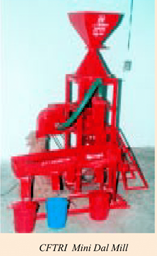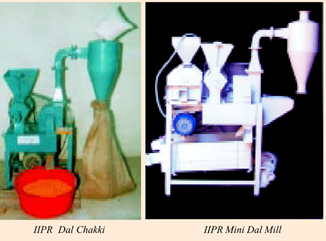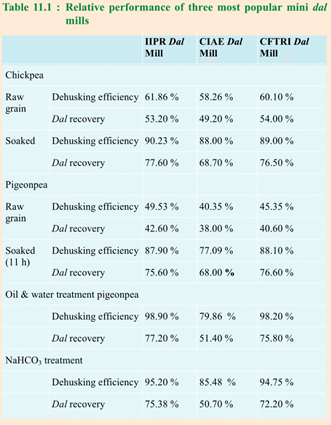Mini Dal Mills
Mini Dal Mills
Efforts have been made to develop improved methods and machinery to process pulses more efficiently and economically at various Research and Development institutions in the country. Notable among them are IARI New Delhi, CIAE Bhopal, PKV Akola, GBPUA&T Pantnagar, CFTRI Mysore, IIPR Kanpur etc.
However, some private entrepreneurs and State Agro Industries have also come up with certain milling machineries but they have localized presence and performance has not been properly documented. Mostly they have been developed by slightly modifying the traditional milling machine or the designs developed at R&D institutions. The salient features of these machineries are presented in the following paragraphs :
IARI dehusking CUIITT splitting machine
It is a small capacity, low cost and portable type of machine. It consists of a cylinder concave set, a feed hopper and or blower. All these parts are mounted on angle-iron frame. The clearance between the cylinder and the concave is adjustable. A blower with duct is also provided with the machine, which facilitates separation of hull from the mixture of dal unhusked pulse and husk. The machine is run with the help of 1hp, 3-phase electric motor. The husk is removed due to rubbing of grains between the moving rough surface of the cylinder and the stationary rough surface of the concave. The dehusking and splitting also occur due to impact force. The mixture of husk, unhusked grains and splits falls from the bottom outlet of the machine. This mixture is simultaneously subjected to air blast, which removes the husk, and other lighter materials. The dehusked dal and splits are collected at the main outlet. It is claimed that the dehusking efficiency of 94%, 97% and 98% was achieved for soybean, chickpea and pea, respectively. The splitting efficiency of the machine is claimed at 98% with 10% broken.
CIAE dehusking and splitting machine
CIAE Bhopal has developed a low cost dehusking and splitting dal mill for rural use. The machine consists of an abrasive carborundum roller dehusker and has a capacity of 100 kg/hr. This machine can be owned, operated and manned by less skilled people of rural and semi-urban areas. The mill operates with a 1.5 KW, 3 phase electric motor. The cost of milling was estimated to be Rs. 14.0 per quintal. The average recovery in case of pigeonpea, mungbean and urdbean was claimed to be 75% and 74% each, respectively. As water treatment is recommended with the mill, the use of edible oil in the process of dehusking has been completely eliminated in this process.

PKV mini dal mill
The mill consists of four units viz., splitting unit, sieve, aspirator and polisher. The premilling treatment is given by soaking difficult to mill pulses grains in sodium bicarbonate solution.
The splitting unit is comprised of two emery discs run 1.0 hp, single phase electric motor. One of the discs is fixed and another is revolving type. The clearance between them is adjusted by screw mechanism operated by hand wheel. The capacity of this unit is 40-45 kg per hour for pigeonpea and around 60 kg per hour for mungbean and urdbean. The sieve unit consists of two reciprocating type of easily removable. Different sizes of sieves are required for various grain sizes. It separates mixture in three different parts coming out from individual outlets, lower one is for broken, middle for dal and upper are retains the mixture of husked and dehusked grains. The aspiration unit consists of two blowers (aspirators) and a cyclone separator. One of the aspirator positioned near the outlet of splitting unit separates only husk and powder from the milled mixture and provides dust free operation. The second aspirator separates husk from dal moving from the polisher unit. Both the aspirators are connected to a cyclone separator, which collects powder from the mixture of husk and powder so as to avoid its spreading in the atmosphere. In polisher, polishing is done with the help of two screw conveyors wrapped with leather and enclosed in a casing. The friction of dal between leather and inner surface of casing enables to polish it and removes the husk, which still adheres to dal.

It is necessary to give pre-treatment to pigeonpea grains before milling. Grains are soaked in 6% solution of Sodium bi-carbonate for 40 minutes and dried. The grains of mungbean and urdbean do not require any premilling treatment. In case of pigeonpea, the maximum efficiency over 72% can be obtained. This machine is recommended to be use at cottage industries level.
CFTRI hand operated pulse dehusking machine
CFTRI, Mysore has developed a hand-operated abrasion type of machine for processing of pulses at household level. It can perform both dehusking and splitting operation while causing minimum breakage and powdering. The machine can dehusk 40-60 kg pre-conditioned pulse per hour. The suitably pre-treated pigeonpea, chickpea, soybean and peas are the pulses which can be dehusked by this machine. The husk and brokens are separated by winnowing and sieving. It is claimed that this machine can achieve 95-98% dehusking and the yield of head dal is obtained around 75-80%. Motorized version of this machine is also available. This machine is easy to operate, and can be maintained and repaired at rural level. This machine has been designed and developed with an intention of replacing the traditional chakkis.
CFTRI mini dal mill
This mill developed at CFTRI can dehusk 100-150 kg of pre-treated pulse per hour and is recommended to be used for tiny scale. The mill has a capacity to dehusk 100-150 kg of pre-conditioned pulse per hour. The mini dal mill consists to dehusking and splittting unit, aspirator and separator unit runs by 1 hp single-phase motor. Bold pulses such as pigeonpea, chickpea, peas and soybean can be dehusked in this machine.

Formungbean and urdbean, splitting of unhusked grains can also be achieved in the mill. It is claimed that this mill gives a yield of 77–80% and dehusking efficiency of 97-99%. This is an integrated unit and comes with a grader, which runs on 1/2 hp single phase motor and can grade 200-250 kg of soaked (wet) pulse per hour. In this machine, grains are dehusked and split simultaneously. Dehusking is achieved by abrasion of grain between the rotating emery coated cone and wire mesh cage. Aspirator separates the husk and broken are segregated in the reciprocating sieve assembly. The dehusked and unhusked grains are collected at different points. The machine gives higher yield and good quality dal at comparatively lower processing costs. This technology ensures pollution free atmosphere besides low power consumption. This minidal mill is simple in design, easy to operate and can be repaired and maintained at rural level.
Pantnagar manually operated dal mill
This mill is designed to be used by farmers at cottage scale with a view to enable them to market their produce after primary processing so as to augment their income. It comprises of hopper, screw conveyor, emery rollers and cylindrical separators. The mill has a capacity of 50 kg/hr. The mill can be operated with the help of paddles. The dal is treated with 10% sodium bi-carbonate solution followed by tempering and drying to 10% moisture content. It gives 75% dehusking for pigeonpea grains. The mill was found effective for urdbean, chickpea, soybean etc. The yield of head dal is 50 kg/hr and broken amount to 5-6%. Only one labour is required to operate this mill.

Pantnagar mini dal mill
It consists of emery rollers, hopper, conveyors and separators. The machine is operated with the help of 1.0 hp motor and has a capacity of 100 kg/hr. This has been designed to process pigeonpea only. It requires five hours for the complete milling operation. The pre-treatment is done with the help of 10% NaHCO, solution. The milling yield is 50 kg/hr of dehusked dal and 80% dehusking efficiency can be obtained with this machine.
The first prototype of IIPR Mini Dal Mill was developed in 1992, since then the various upgraded models of the mill have been developed and commercialized. About 175 units of this mill have been established in different parts of the country. The machine basically comprise of feeding unit, milling unit and cleaning unit. Feeding unit consists of a feed hopper and auger type feed mechanism, which maintains uniform flow of treated pulse grains to the milling unit. Milling unit is a vertical attrition unit, comprising of stationary rubber and rotating corrugated steel disks. Gap between the two disks can be increased or decreased depending on pulse crops and grain size of the cultivars. The milled product is exposed to air suction through a blower and, husk and powder is separated by means of cyclone separator. Due to use of rubber disk IIPR Mini Dal Mills yields 510% higher dal recovery for different pulse crops, when compared to emery roller type mills.
Since its evolution in 1992, IIPR Mini Dal Mill has undergone several upgrades. These upgraded models were developed based on feedback received from farmers and entrepreneurs using the machine. The latest model of the mill has the provision of grading raw material as well as finished product. Grading of raw material facilitates uniform gap between the disks during milling operation. Grading of finished product separates the different fractions of milled product. Apart from this, an emery roller of 3810 x 1524 mm is attached to the mill to carry out pitting operation. Pitting facilitates faster rate of pre-milling treatment and reduces residence time significantly. This roll also enables the mill to produce ‘gota' (dehusked whole) from lentil, called “Malka Masoor', which was difficult to produce in earlier models as most of the dal produced gets split in vertical attrition mills. Refinement in disk holding mechanism and quality of rubber disk has also been made. All pitting, milling, cleaning and grading operations can be done simultaneously in the new model. This machine can also be used for ‘dalia' making and making grits for animal feed. To produce ‘dalia’ or grits rubber disk is replaced with steel disk to crush the material. Use of the machine can easily generate a monthly profit of Rs. 5,000/- per month along with providing employment for three. This mini dal mill has an immense potential for being exploited as cottage scale industry for the benefit of rural entrepreneurs, unemployed youth and progressive farmers.


Last Modified : 3/1/2020
Technologies developed and commercialised by CIPHE...
